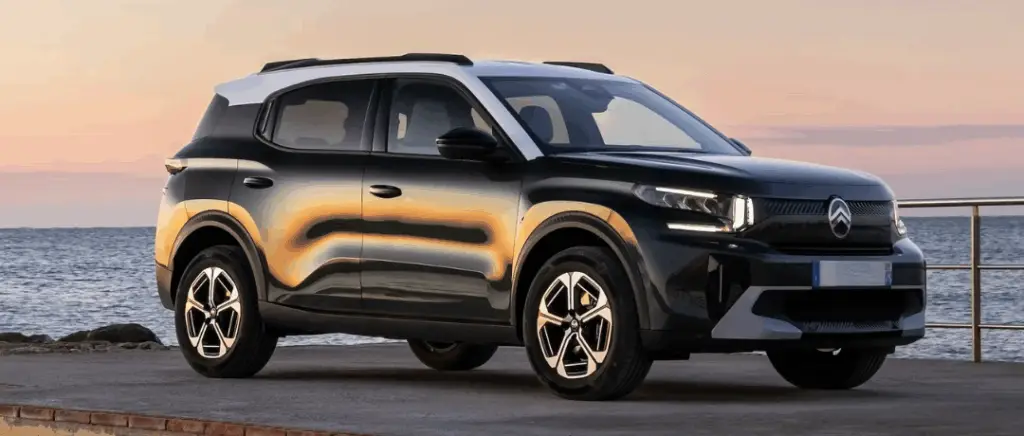Our top 10 selection of electric saloons in 2025
1 - Tesla Model 3
La Tesla Model 3 2025 is based on a dedicated electric platform from Teslawith LFP or NMC lithium-ion batteries, depending on the version. It offers autonomy WLTP up to 629 km for the Long Range Dual Motor AWD version, with an engine output of around 441 bhp, accelerating from 0 to 100 km/h in just 4.4 seconds. As for charging, the Model 3 can be recharged on the Supercharger network V3 with a maximum power of 250 kW, giving you almost 280 km of range in just 15 minutes.
Complete home recharging with a AC terminal 11 kW takes around 7h45. Average fuel consumption is between 14 and 16 kWh/100 km, which is very efficient for a saloon in this category. The price of the Standard RWD version starts at around €39,990with leasing (LOA and LLD) available from around €526 per month according to market offers, making it an efficient, economical and practical choice for daily use or long-distance journeys.
2 - Polestar 2
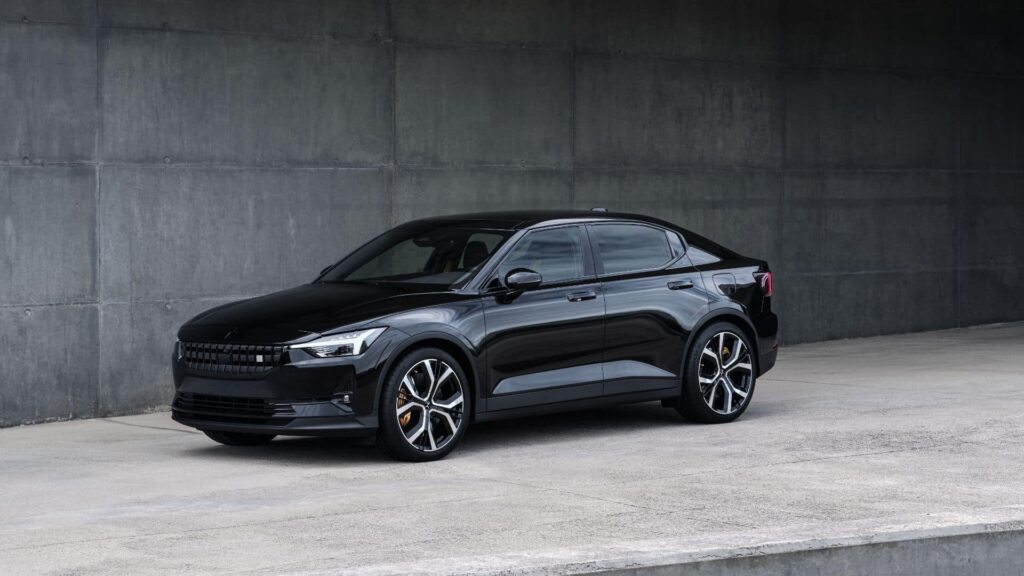
La Polestar 2 embodies Scandinavian elegance thanks to a modified SPA platform, designed by Volvo for total electrification. Its battery of 78 kWh gives it a range between 480 and 540 km depending on the version chosen (rear-wheel drive or Dual Motor AWD). The engine can produce up to 300 bhp and 660 Nm of torque, enabling the car to accelerate from 0 to 100 km/h in 4.7 seconds. When it comes to recharging, power rises to 150 kW in direct current, providing 80% of battery in around thirty minutes, while a full charge at a home AC terminal takes almost 8 hours.
Fuel consumption varies between 18 and 20 kWh/100 km. In terms of pricing, the Polestar 2 starts around 48 000€with offers LOA/LLD available from €529 per month, making this model accessible to premium customers with a keen eye for design and technology.
3 - Hyundai Ioniq 6
Based on the E-GMP platform, the Hyundai Ioniq 6 impresses with its aerodynamics and energy efficiency. Its 77.4 kWh battery offers autonomy beyond 610 km WLTP. It develops up to 311 bhp, with a 0-100 km/h time of just 5.1 seconds. Thanks to the 800 V architecture, ultra-fast recharging reaches 350 kW, enabling the car to recover 100 km in less than 5 minutes, and 80% of charge in 18 to 20 minutes. Fuel consumption is remarkable, at between 13 and 15 kWh/100 km.
This saloon is priced from 52 000€with leasing offers from €549/month depending on the finish, offering an excellent efficiency/technology ratio.
4 - Mercedes CLA
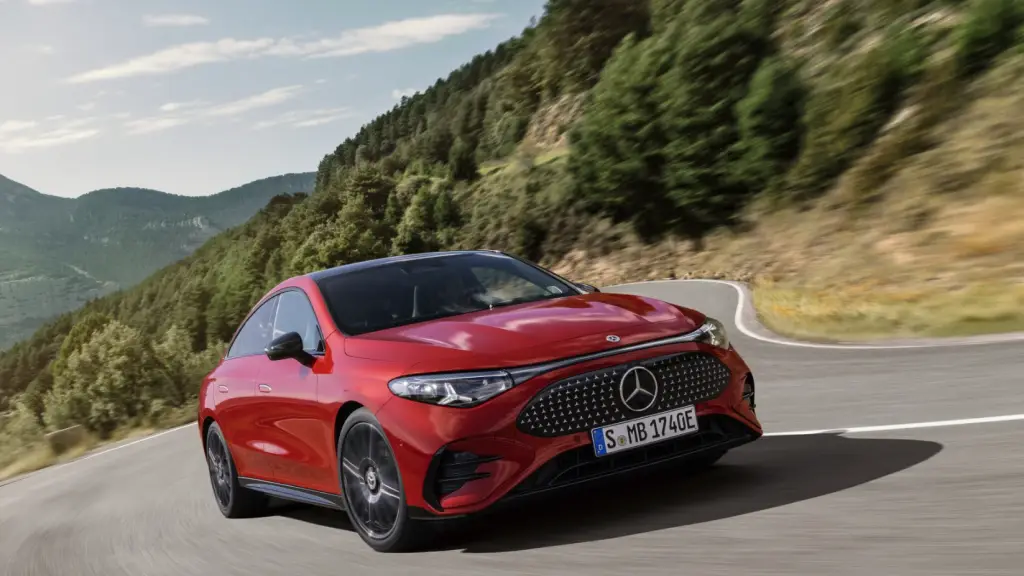
Based on the dedicated EVA2 platform, the Mercedes CLA electric combines refinement and innovation. Sound WLTP range of around 440 km thanks to a 70 kWh battery. Power ranges from 200 to 292 bhp, with a 0-100 km/h time of 6 to 7 seconds depending on the engine. CCS rapid charging increases to 100 kW, enabling a charge of 10 to 80% in around thirty minutes.
Fuel consumption is between 18 and 20 kWh/100 km. The price starts at around €49,900, and leasing solutions are available from 569/monthThese are designed for drivers who want to combine prestige with clean mobility.
5 - BYD Seal
La BYD Sealthe latest addition from the Chinese manufacturer, is based on the e-Platform 3.0 platform. Its 61 to 70 kWh battery offers a WLTP range of around 550 km. It produces 330 bhp and accelerates from 0 to 100 km/h in 4.7 seconds. With rapid charging up to 140 kW, you can go from 30 to 80% in about 25 minutes Recharging at an AC terminal takes 8 to 9 hours.
Fuel consumption averages 16 to 17 kWh/100 km. Posted at from €45,000the BYD Seal is available in leasing from €429/monthA good compromise between price and technological innovation.
6 - Tesla Model S
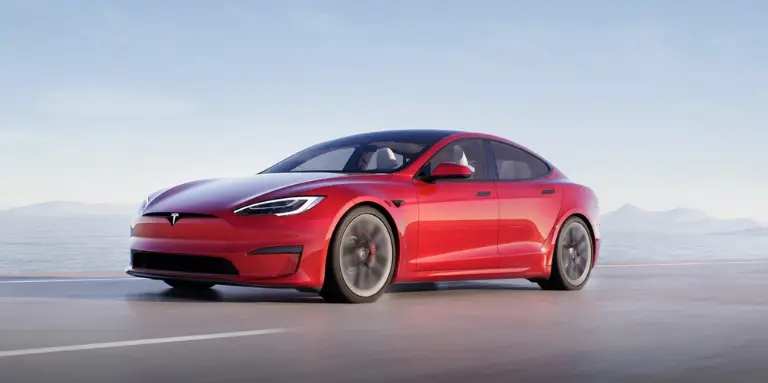
The flagship of the brand, the Tesla Model S uses the manufacturer's top-of-the-range platform with 90 to 100 kWh batteriesfor a range of up to 720 km WLTP. The Plaid version offers up to 1,020 bhp and a 0-100 kph time of 2.1 seconds.
Thanks to Supercharger V3 charging at up to 250 kW, you can recover 80% of range in less than 30 minutes. Fuel consumption is between 18 and 20 kWh/100 km. Prices start at around 95 990€with long-term leasing options tailored to premium customers, generally from €1,340/month.
7 - BMW i4 eDrive40
La BMW i4 eDrive40 uses the Neue Klasse platform with a battery of almost 80 kWh, guaranteeing up to 590 km WLTP range. Its engine develops 333 bhp, enabling it to go from 0-100 km/h in 5.7 seconds. On direct current, the car can accept up to 205 kW, enabling it to go from 10 to 80% in around 31 minutes, while charging on AC takes around ten hours.
Average fuel consumption is between 16 and 18 kWh/100 km. Expect a starting price €59,700or a leasing from €579/month for this dynamic, comfortable saloon.
8 - Volkswagen ID.7 Pro
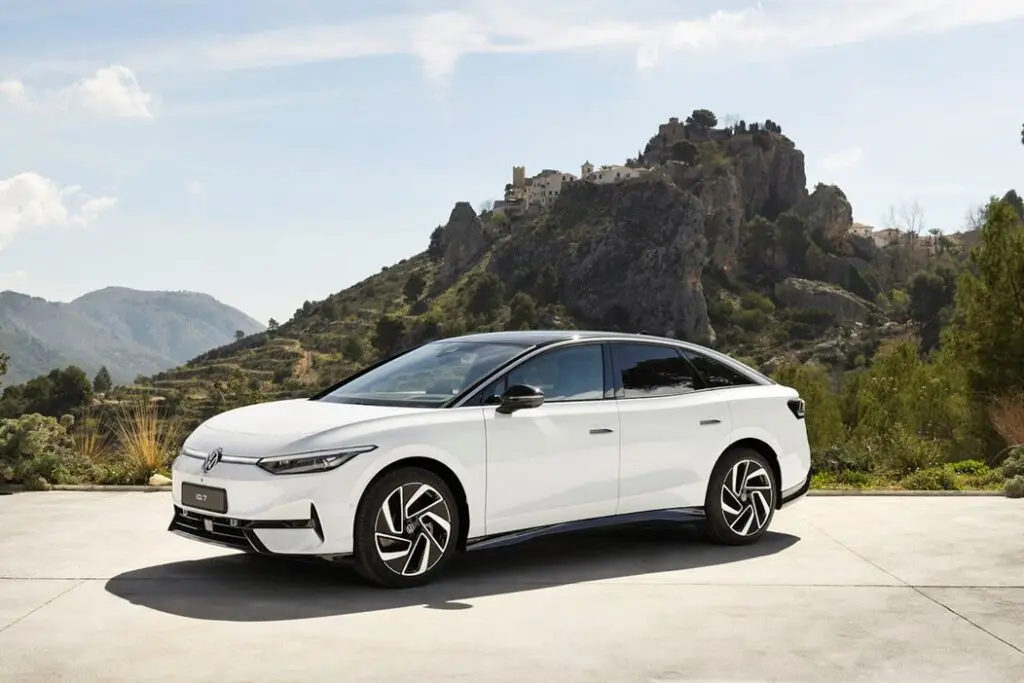
With its MEB platform and 77 kWh battery, the Volkswagen ID.7 Pro offers a range in excess of 700 km WLTPideal for long family journeys. Its power varies between 286 and 300 bhp depending on the version, with a 0-100 km/h time of around 7 seconds.
CCS rapid recharging at 170 kW makes it possible to reach 80% charge in 30 minutes. Its fuel consumption remains contained, at between 16 and 18 kWh/100 km. The base price is around €56,990, with options to choose from. LLD/LOA from €520/month.
9 - Mercedes EQE
La Mercedes EQE is also based on the EVA2 platform, like the EQS, but in a more compact format. Its 90 kWh battery provides approximately 600 km range WLTP. It offers up to 389 bhp, delivering a 0-100 km/h time of 5.5 seconds. The 170 kW rapid recharge system recharges the battery from 10 to 80% in 30 minutes. Fuel consumption remains moderate, at around 18 kWh/100 km.
Le price starts at €75,000while the leasing starts at €829/month for this top-of-the-range saloon.
10 - Porsche Taycan
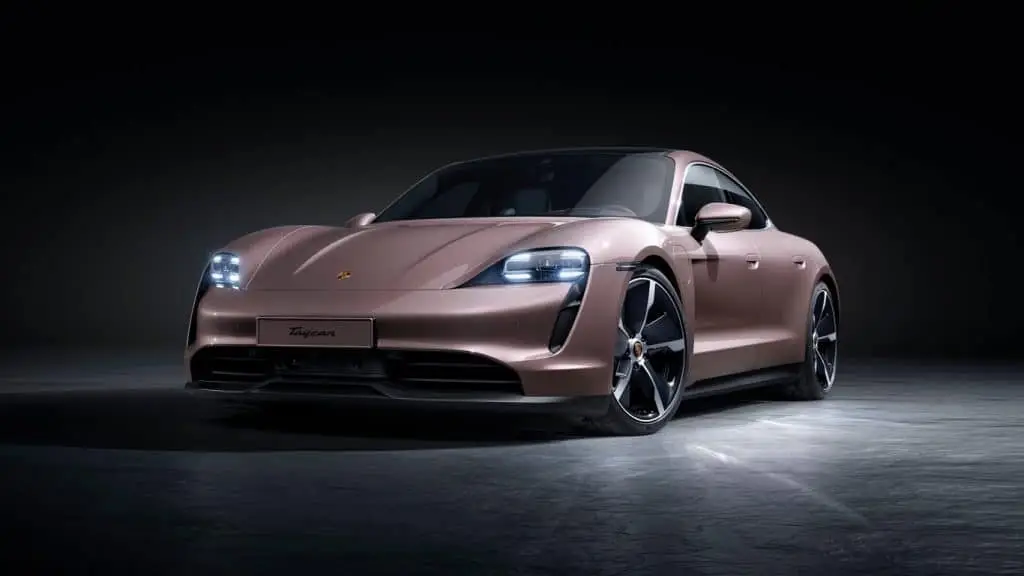
La Porsche Taycan is based on the J1 platform, with an 800-volt architecture and a 79.2 kWh battery for around 400 km of WLTP range. The most powerful versions deliver up to 625 bhp, with a 0-100 km/h time of just 3.2 seconds (Turbo). An ultra-fast 270 kW charge restores 100 km of range in around 5 minutes, while fuel consumption varies between 20 and 23 kWh/100 km, typical of sporty driving.
La Taycan starts at €99,250with a leasing around €1,299/monthideal for lovers of thrills and automotive luxury.
Summary of the top 10 electric saloons
| Model | Platform | WLTP range (km) | Power (hp) | 0-100 km/h (s) | Rapid recharge (kW) & duration | Fuel consumption (kWh/100 km) | Price (€) | Monthly lease (€) |
|---|---|---|---|---|---|---|---|---|
| Tesla Model 3 | Tesla platform (LFP/NMC) | 629 | 441-460 | 4,4 | 250 kW / 15 min (280 km) | 14 - 16 | 39 990 | From 526 |
| Polestar 2 | Modified Volvo SPA | 480 - 540 | Up to 300 | 4,7 | 150 kW / 27-30 min (80%) | 18 - 20 | 48 000 | From 529 |
| Hyundai Ioniq 6 | Hyundai E-GMP | >610 | 311 | 5,1 | 350 kW / 18-20 min (80%) | 13 - 15 | 52 000 | From 549 |
| Mercedes CLA EQ | Mercedes EVA2 | ~440 | 200 - 292 | 6 - 7 | 100 kW / 30-35 min (80%) | 18 - 20 | 49 900 | From 569 |
| BYD Seal | BYD e-Platform 3.0 | 550 | Up to €330 | 4,7 | 140 kW / 25 min (30-80%) | 16 - 17 | 45 000 | From 429 |
| Tesla Model S | Tesla platform | 720 | Up to 1020 | 2,1 | 250 kW / 20-30 min (80%) | 18 - 20 | 95 990 | From €1,340 |
| BMW i4 eDrive40 | BMW Neue Klasse | 590 | 333 | 5,7 | 205 kW / 31 min (10-80%) | 16 - 18 | 59 700 | From 579 |
| Volkswagen ID.7 Pro | VW MEB | >700 | 286 - 300 | 7 | 170 kW / 30 min (80%) | 16 - 18 | 56 990 | From 520 |
| Mercedes EQE | Mercedes EVA2 | 600 | Up to €389 | 5,5 | 170 kW / 30 min (10-80%) | 18 | 75 000 | From 829 |
| Porsche Taycan | Porsche J1 (800 V) | 400 | Up to $625 | 3,2 | 270 kW / 5 min (100 km) | 20 - 23 | 99 250 | From €1,299 |
Essential criteria for choosing an electric saloon
To choose the right electric saloon for your needs in 2025, there are a number of essential criteria to guide your choice. L'autonomy is still a priority: you need to assess the actual distance you cover every day and anticipate your long-distance journeys, taking into account variations linked to the climate or driving style. Visit power of the engine, expressed in horsepower, influences not only performance but also driving comfort, with more dynamic acceleration.
Le recharge time is crucial, depending on whether you can install a home charging point or rely on fast public charging points: a fast charge (over 100 kW) will save you precious time.
Le purchase priceincluding the price of the car and options, must be measured taking into account government aid and the various options available. leasing formulaswhich make it easier to access premium models.
Finally, the energy consumption (kWh/100 km) impacts your long-term energy budget and reflects the overall efficiency of the vehicle. You should also consider interior space, boot space and technological equipment to ensure that the saloon is comfortable and practical, particularly for family or professional use. All these criteria combine to make an informed choice, combining performance, range, budget and everyday comfort.
What support or advantages will there be in 2025 for buying an electric saloon?
In 2025, a number of financial incentives and advantages are still available in France to encourage the purchase of an electric saloon car, even though certain regulatory changes have been made. Here are the main schemes:
- Le environmental bonus is still the main form of financial assistance for private individuals wishing to buy a new electric car. As of 1 July 2025, it has been replaced by a bonus based on the following criteria Energy Savings Certificates (CEE), with amounts of up to 4 200 € for low-income households (reference tax income per unit between €16,301 and €26,200), and around 3 100 € for other households, subject to income and strict environmental criteria (including an overall environmental score assessing the production and transport of the vehicle).
- To be eligible, the vehicle must be 100% electric, new, not have been previously registered and cost less than €47,000 including tax (beyond that, the aid is greatly reduced or excluded). In addition, new rules favour models produced in Europe, in order to reduce the carbon impact of manufacturing and transporting the vehicle.
- Purchase subsidies for businesses and electric commercial vehicles have recently been restricted or abolished, mainly targeting private individuals.
- In addition to this bonus, there are local and regional grants that can be used to top up the bonus, as well as financing schemes such as the microcredit clean vehicle or the zero-rate loan to facilitate the acquisition or conversion of a thermal vehicle electric.
- For thehome installation of a charging pointa 500 tax credit is granted per connected or controllable terminal, which is a major advantage for everyday recharging.
- It should be noted that the retrofit premium (conversion of combustion vehicles to electric) is also encouraged.
- For vehicles ordered before 1 July 2025 and delivered before 30 September 2025, the old eco-bonus scheme will still apply, with the usual terms and conditions.
These grants will make the purchase or lease of an electric saloon car in 2025 more accessible, particularly for individuals on modest to intermediate incomes, while promoting more environmentally-friendly and European models. The framework remains subject to a limited budget, which may lead to a temporary suspension of support once the budget has been reached.
Conclusion
In conclusion, choosing an electric saloon in 2025 means finding the right compromise between range, performance, recharging time and cost. Whether you're a private driver or a fleet manager, technologies are evolving rapidly, and leasing offers and charging station installation solutions are making these vehicles increasingly accessible. Based on the key criteria and models presented, you are now better equipped to make an informed choice and participate in the transition to greener, more responsible mobility.
If you're still asking questions, call on beev to answer all kinds of queries: our experts are on hand to help you make the right choices and take the right steps.































